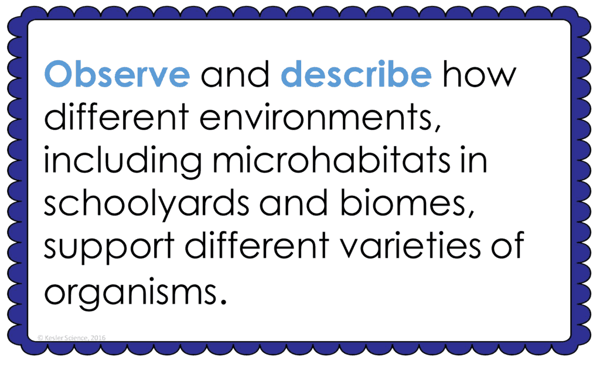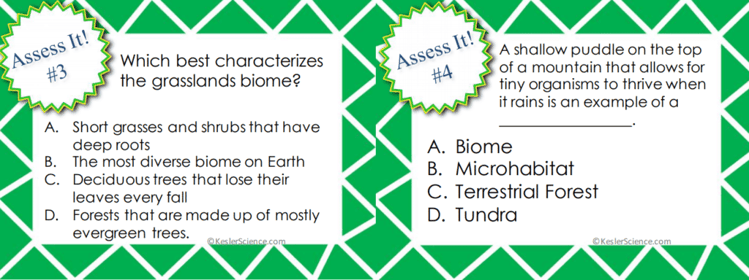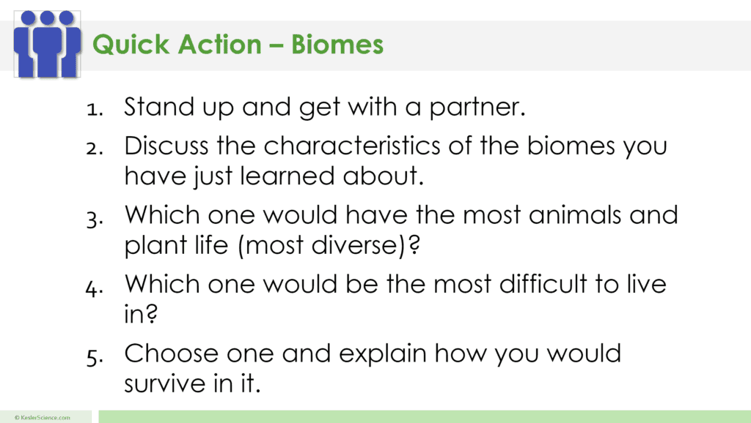BIOMES LESSON PLAN – A COMPLETE SCIENCE LESSON USING THE 5E METHOD OF INSTRUCTION
At the end of this comprehensive biomes lesson plan, students will be able to observe and describe how different environments, including microhabitats in schoolyards and biomes, support different varieties of organisms. Each lesson is designed using the 5E method of instruction to ensure maximum comprehension by the students.
The following post will walk you through each of the steps and activities from the biomes lesson plan.
ENGAGEMENT
At the beginning of the lesson, the class will do a Think-Pair-Share to discuss the objective. Students will then be asked to describe the characteristics of the area in which they live in. The teacher will lead the class in a discussion on climate, animals, and plants. Students will then observe leaves that represent 3 different biomes and list reasons why the leaves might be different. Teacher and students will then cover relevant vocabulary.
The teacher will help to clear any misconceptions about biomes. Some of those are how students seem to think that all organisms "get along" within their respected biome and that ecosystems are dynamic and change as a result of both natural and human-influenced processes
Estimated Class Time for the Engagement: 20-30 minutes
EXPLORATION
This student-centered station lab is set up so students can begin to explore biomes. Four of the stations are considered input stations where students are learning new information about biomes, and four of the stations are output stations where students will be demonstrating their mastery of the input stations. Each of the stations is differentiated to challenge students using a different learning style. You can read more about how I set up the station labs here.
EXPLORE IT!
Students will be working in pairs to match biome cards with their characteristics. Students will then list 3 types of microhabitats. Once students have completed giving examples, students will then list any biomes that they have visited, and where they think the biome that supports the most biodiversity is located.
WATCH IT!
At this station, students will be watching a 4-minute video describing biomes and communities. Students will then answer questions related to the video and record their answers on their lab station sheet. For example, students will list 3 biomes discussed in the video and characterize one of them, including information such as climate, vegetation, etc.
RESEARCH IT!
The research station will allow students to get online and participate with an interactive map of the biomes across the globe. Students will be researching different biomes, vegetation in each, animals that live in certain biomes, and re-hit biodiversity in certain areas. With each concept, students will answer a few questions to help make the research more concrete.
READ IT!
This station will provide students with a one page reading about microhabitats. In the reading, students will discover how biomes can come in many different sizes. Microhabitats can be as small as lichens thriving on boulders. Students will then answer 4 multiple choice questions like identify how different a microhabitat is compared to a biome, differences between lichens in the soil to those on boulders, and how many microhabitats can trees have?
ASSESS IT!
The assess it station is where students will go to prove mastery over the concepts they learned in the lab. The questions are set up in a standardized format with multiple choice answers. Some questions include: identify characteristics of biomes, explain how the decline of the rainforest will impact the Earth, identify characteristics of a grassland biome, and provide information about a microhabitat.

WRITE IT!
Students who can answer open-ended questions about the lab truly understand the concepts that are being taught. At this station, the students will be answering three questions like explain the difference between a biome and microhabitat, describe how a biome can change over time, write factors that contribute to different biomes across the world.
ILLUSTRATE IT!
Your visual students will love this station. Students will be showing off their color-by-number skills to show the different biomes across the globe. Students will identify numbers from the key on a map that represents that certain biome and color those sections of crust on the map.
ORGANIZE IT!
The organize it station allows your students to see a map that shows the many biomes that make up the Earth. Students will determine where the most tropical rainforests, deserts, and tundras are located. Students will also discover what biomes are found in the United States.
Estimated Class Time for the Exploration: 1-2, 45 minute class periods
EXPLANATION
The explanation activities will become much more engaging for the class once they have completed the exploration station lab. During the explanation piece, the teacher will be clearing up any misconceptions about biomes with an interactive PowerPoint, anchor charts, and interactive notebook activities. The biomes lesson includes a PowerPoint with activities scattered throughout to keep the students engaged.
The students will also be interacting with their journals using INB templates for biomes. Each INB activity is designed to help students compartmentalize information for a greater understanding of the concept. The biomes INB template will describe the different characteristics and organisms that make up each Earth biome.
Estimated Class Time for the Exploration: 2-3, 45 minute class periods
ELABORATION
The elaboration section of the 5E method of instruction is intended to give students choice on how they can prove mastery of the concept. When students are given choice the ‘buy-in’ is much greater than when the teacher tells them the project they will have to create. Each of the biome projects will allow students to show their understanding of a biome.
Estimated Class Time for the Elaboration: 2-3, 45 minute class periods (can also be used as an at-home project)
EVALUATION
The final piece of the 5E model is to evaluate student comprehension. Included in every 5E lesson is a homework assignment, assessment, and modified assessment. Research has shown that homework needs to be meaningful and applicable to real-world activities in order to be effective. When possible, I like to give open-ended assessments to truly gauge the student’s comprehension.
Estimated Class Time for the Elaboration: 1, 45 minute class period
DOWNLOAD THE FULL LESSON NOW
The full lesson is available for download from the Kesler Science Store. Save yourself a ton of time and grab it now.
Download Over $100 in FREE Resources
For Middle School Science
Simply create a login below and gain immediate access to a selection of our Kesler Science product line worth $100 - for FREE. There's a full version of every product type! You'll also join tens of thousands of middle school science teachers who receive timely tips and strategies straight to their inbox.




